
Hot (Black)
Neutral (White)
Load
Blue
(Control)
Black
Red
Red
Blue
White
Black
White
Black
Red
Blue
Blue
Blue
Black
Black
Line
120-277-347 VAC
60Hz
Sensor
OSPxx Series
Power Pack
To BAS
System
To BAS
System
N/C - Brown
N/O-Brown/White
Common-Green
N/C - Brown
N/O-Brown/White
Common-Green
Infrared Ceiling Mounted Occupancy Sensor
Cat. No. OSC
Ø
4-R and OSC15-R
To be used with 24VAC/VDC OSPxx Series and CN100 Power Pack or other Class 2 power supplies
INSTALLATION INSTRUCTIONS
Mount in center of
room/area, 8-10ft height
Mount in center of
room/area, 8-10ft height
Suggested
Mounting Location
450 sq. ft.
1500 sq. ft.
Coverage
Isolated Relay
1A @ 30VAC/VDC
Isolated Relay
1A @ 30VAC/VDC
HVAC Relay
OSC04-RIW
OSC15-RIW
Cat. No.
High
Density
Extended
Range
Description
15-28VAC/VDC
15-28VAC/VDC
Voltage Range
15mA DC, 30mA AC
15mA DC, 30mA AC
Current
Consumption
CATALOG ITEMS
INSTALLING YOUR OCCUPANCY SENSOR
NOTE: Use check boxes when Steps are completed.
Low-Voltage Wires Low-Voltage Wires
Sensor Back
Cover
Sensor Base
Keylock Arrow
Mounting
Screws
(2 places)
Sensor Front Cover
Wallboard Ceiling
Back Cover open center to
route Low-Voltage Wires
Mounting Screw
Back Cover internal
surface shown
Back Cover shown mounted
on ceiling with screws
Nut (2 places)
Washer (2 places)
Wallboard
Ceiling
#8-32 Screws
(2 places)
Octagon Box
4" x 1-1/2" deep
Low-Voltage
Wires
Wallboard or
Drop Ceiling
Wire Mold Back Cover
Back Cover Screws
(4 places)
Wire Mold Round Fixture
Box Cat. No. V5738
(for raceway mount)
Mounting Screws
(4 places)
Low-Voltage Wires
Wallboard Ceiling
Wire Mold Raceway
(use applicable fittings)
Occupancy Sensor Mounted to Octagon
Box Installed Flush to Wallboard Ceiling
Occupancy Sensor Mounted to Round Fixture
with Raceway for Wallboard Installation
Wiring Diagram: Multiple Sensor, Single Power Pack
NOTE: Ensure to
cap wires that are
not being used.
Low-Voltage Wires
NOTE: Wires threaded through
the Threaded Rod
Drop Ceiling
1" thick maximum
Nut
Washer
Threaded Rod
Mounting Option Diagram A
Occupancy Sensor Mounted to Drop Ceiling Using Threaded Rod
Mounting Option Diagram B
Occupancy Sensor Mounted to Wallboard or Drop Ceiling Using Screws
PK-93733-10-00-0A
TABLE 2: WIRE DESIGNATIONS
Name
Power (24 VAC/VDC)
Common
Occupancy
Relay
Color
Red
Black
Blue
Brown (N/C)
Brown/White (N/O)
Green (Common)
Gage
24
24
24
24
24
24
Temp/Voltage
200° C/ 600V
200° C/ 600V
200° C/ 600V
200° C/ 600V
200° C/ 600V
200° C/ 600V
Step 3 cont'd Step 3 cont'd
A. Drop Ceiling Installation (Mounting Option A):
NOTE: Use the threaded rod included.
1. Select location for mounting of sensor and proper masking for your application
(refer to Mounting Location Diagram).
2. Use the supplied threaded rod or other methods to make a hole (1/2" to 1") in the ceiling
tile just large enough to pass the body of the threaded rod through.
3. Insert the sensor wires through the flared end of the threaded rod. Position the threaded
rod to the base of the sensor.
4. Insert the flared end of the threaded rod into the opening in the bottom of the sensor
and twist to lock into place.
DESCRIPTION
The Occupancy Sensor is a low-voltage infrared sensor that works with the OSPxx
Series and CN100 power pack, or other Class 2 power supplies, to automatically
control lighting. The sensor turns the lights on and keeps them on whenever occupancy
is detected and will turn them off after the ‘delayed-off time’ has expired.
The sensor continually analyzes and adjusts to changing conditions. The sensor uses
the latest microprocessor-based technology which permits it to continually adjust and
optimize its performance.
Infrared motion detection gives higher false triggering immunity that yields a sensor
with excellent performance.
Tools needed to install your Sensor
Slotted/Phillips Screwdriver Electrical Tape
Pliers Pencil Cutters
Parts Included List
Sensor (1) Threaded Rod (1) and Hex Nut (1)
#8-32 x 1/2" Screw (2) Half Mask (1)
#8-32 x 1-1/2" Screw (2) 360° Perforated Mask (1)
#8-32 Washer and Nut (2) Plastic Washer (1)
WARNINGS AND CAUTIONS:
• TO AVOID FIRE, SHOCK, OR DEATH; TURN OFF POWER AT CIRCUIT BREAKER OR FUSE AND TEST THAT
POWER IS OFF BEFORE WIRING!
• To be installed and/or used in accordance with appropriate electrical codes and regulations.
• If you are unsure about any part of these instructions, consult an electrician.
• Sensors must be mounted on a vibration free surface.
• Do not terminate using data type wire, such as Cat 5/5E.
• All sensors must be mounted at least 6 feet away from air vents, air handlers, and reflective surfaces (windows/mirrors).
• Do not touch the surface of the lens. Clean outer surface with a damp cloth only.
ONOFF
ONOFF
ONOFF
ONOFF
ONOFF
ONOFF
ONOFFONOFF
ONOFF
ONOFF
ONOFF
ONOFF
WARNING: TO AVOID FIRE, SHOCK, OR DEATH; TURN OFF
POWER at circuit breaker or fuse and test that power is off before wiring!
Step 1
Cut
(if necessary)
1/2"
(1.3 cm)
Strip Gage
(measure bare
wire here)
Step 2
Preparing and connecting wires:
Typical Installations:
Step 3
Listed are 3 typical installation options (A, B, and C). Choose one that
best suits your needs. Other methods of installation may be possible but
they have not been described here.
5. Push the wires into the hole in the ceiling tile and insert the threaded rod until the
sensor is flush with the tile.
6. Insert wires through the hole in the included washer, then place the included washer
over the rod and screw on the included hex nut.
7. Class 2 Wiring: Connect low-Voltage wires from Power Pack to Sensor per WIRING
DIAGRAM as follows: Twist strands of each lead tightly and, with circuit conductors,
push firmly into appropriate wire connector. Screw connectors on clockwise making
sure that no bare conductor shows below the wire connectors. Secure each connector
with electrical tape.
8. Rotate the sensor to the desired orientation. Note that the sensor base and back cover
are keyed. To lock the device in place, ensure that the arrows are not aligned.
9. Restore power at circuit breaker or fuse to Power Pack. INSTALLATION IS
COMPLETE. NOTE: All wired connections to the sensor are Class 2 low voltage.
B. Wallboard or Drop Ceiling Installation (Mounting Option B):
NOTE: You may use the mounting screws, nuts and washers included, or screws in
combination with commercially available wall anchors.
1. Select location for mounting of sensor and proper masking for your application
(refer to Mounting Location Diagram).
2. Make a hole in the ceiling tile or wallboard large enough to pass the wire connections
and wire nuts through (approximately 1" diameter).
3. Remove the back cover of the sensor. Hold the back cover and body of the sensor and
rotate until the two arrows line up and pull apart.
4. Install back cover of the ceiling sensor to the wallboard or drop ceiling using the
included screws, nuts and washers, or screws in combination with commercially
available wall anchors.
5. Class 2 Wiring: Connect low-Voltage wires from Power Pack to Sensor per WIRING
DIAGRAM as follows: Twist strands of each lead tightly and, with circuit conductors,
push firmly into appropriate wire connector. Screw connectors on clockwise making
sure that no bare conductor shows below the wire connectors. Secure each connector
with electrical tape.
6. Push wire connections through the center hole of the back cover and into the ceiling.
7. Secure the sensor body to the back cover by aligning the arrows. Lock it by turning the
sensor such that the arrows do not line up.
8. Rotate the sensor to the desired orientation.
9. Restore power at circuit breaker or fuse to Power Pack.
INSTALLATION IS COMPLETE.
FCC COMPLIANCE STATEMENT:
This device complies with part 15 of the FCC rules. Operation is subject to the following two conditions:
(1) This device must not cause harmful interference, and (2) This device must accept any interference
received, including interference that may cause undesired operation. Any changes or modifications not
expressly approved by Leviton could void the user's authority to operate this equipment.
C. Junction Box or Surface Mount Raceway Installation
(refer to Mounting Diagrams):
NOTE: Listed below are suggested JUNCTION BOX installation applications which
require mounting to conduit in one of the following three ways:
Step 3 cont'd

SETTINGS
Minor Motion, Infrared
Major Motion, Infrared
0
12
5
5
12
0
SIDE VIEW
TOP VIEW
7
7
12
12 5
9
5
3
3
9
8
Figure 2 - (Cat. No. OSC04) Field-of-View Ranges
0
0
20
10
10
20
SIDE VIEW
TOP VIEW
20
11
11
15
15 5.6 5.6
9
9
3
3
20
8
0
Figure 3 - (Cat. No. OSC15) Field-of-View Ranges
Figure 4 - (Mid-Range Lens) Field-of-View Ranges
Note: This lens is included with all PIR models
• For technical assistance, contact us at 1-800-824-3005
• Visit our website at www.leviton.com
PRODUCT INFORMATION
PK-93733-10-00-0A© 2011 Leviton Mfg. Co., Inc.
By masking two sections,
you can block hallway traffic.
Masking is not required in a corner
mounting application. The sensor
cannot see hallway traffic.
Mask
Mounting Location Diagram
Figure 1 - Minimum and Default Settings
MIN. MAX.
Adjust Knob Rotation
Direction
30 sec
5 min
30 min
20 min
10 min
Delayed Off Time Selection
(Black Knob)
A
B
ON ON
1 1
A
B
ON ON
1 1
Minimum Setting
Factory Default Setting
DIP Switches
B3
OPERATION
Motion detection by the infrared sensor will turn on the lights as well as keeping them
on. When motion is not detected, the lights will turn off after the delayed-off time.
• Delayed-Off time – The sensor is designed to turn the lights off if no motion is
detected after a specified time. This length of time is called the delayed-off time
and is set using the timer (Black) knob on the sensor. The adapting patterns will
modify the delayed-off time to fit the parameters of each installation based on
environmental conditions and occupancy patterns.
• Walk-through Mode – The walk-through feature is useful when a room is
momentarily occupied. With this feature, the sensor will turn the lights off shortly
after the person leaves the room.
The walk-through feature works as follows: When a person enters the room, the
lights will turn on. If the person leaves the room before the default walk-through
timeout of 2.5 minutes, the sensor will turn the lights off. If the person stays in the
room for longer than 2.5 minutes, the sensor will proceed to the standard operation.
• LED Operation – There are two LED indicators that will flash when motion is
detected. The LED flash can be disabled using the LED disable switch setting. Red
flash indicates motion detection by infrared technology.
ADAPTIVE FUNCTIONS
The Sensor continually analyzes the parameters of the motion detection signal and
adjusts its internal operation to maximize detection of motion while minimizing the
effects of noise (electrical noise, air currents, temperature changes, etc…).
Operation:
When the lights turn on, the sensor initially enters the “walk-through” mode. Once the
room is occupied for longer than 2.5 minutes, the sensor exits the “walk-through” mode
and enters the “Occupied” mode. When the sensor is first installed, the delayed-off
time for the occupied mode is based on the Time adjustment settings. While the sensor
is in use, the delayed-off time will change, based on how the sensor adapts to the room
conditions. Whenever the sensor subsequently turns on, the value of the delayed-off
time will be the adapted value (refer to Occupancy Pattern Learning For Delayed
Off Time).
The adapted settings can be reset using the DIP switch.
Occupancy Pattern Learning For Delayed Off Time:
The sensor will automatically change the delayed off time in response to the occupancy
and environmental conditions of the space it is installed in. The sensor analyzes the
motion signal properties and will minimize the delayed off time duration when there is
frequent motion detection, and lengthen the delayed off time duration when there is
weak and infrequent motion detection.
In the case of a false-off condition (lights turn off when the room is occupied), the
delayed off time duration will immediately be lengthened to prevent further false turn
offs.
Occupancy Pattern Learning for Infrared Technology:
The sensor learns the occupancy patterns of a space during the course of a day, for
a seven day period. At any given time, the sensor will look at the collected data and
adjust its infrared sensitivity. The sensor will adjust the sensitivity to make it less likely
to turn on during a period of non-occupancy and more likely to turn on during a period
of occupancy.
Adjustment knob settings as per “recommended manual settings,” (refer to Table 3
and Figure 1).
All switches in the OFF position, except A4 is set to ON (refer to Table 4).
TABLE 3 : ADJUSTMENT KNOB SETTINGS
Knob
Color
Red
Black
Function
Sets the infrared
range
Delayed - Off Time
Knob Setting
Range Setting
Full CCW = min. (OFF)
Full CW = max.
Full CCW = min. (30 sec)
Full CW = max. (30 min.)
Symbol
Factory Default
Setting
75 %
50 %
(10 min)
Test Mode:
To set the delayed-off time to 4 seconds for performing a walk test. While the
sensor is in test mode, the LED’s will flash amber once every 6-7 seconds.
1. ENSURE POWER IS ON.
2. Remove front cover.
3. Locate Dip Switch 3 in Bank B (B3) (refer to Figure 1). B3 will be in the OFF position
from the factory.
4. To enter Test Mode, move switch to ON and back to OFF. The test mode has now been
entered with a 4 second time-out. NOTE: If B3 is already in the ON position, then test
mode can be entered by just moving it to the OFF position.
NOTES:
1. The timer will remain in the 4 second test mode for 15 minutes, then automatically exit
test mode and reset to the delayed-off time setting as defined by the black timer knob.
2. To manually take the timer out of the 4 second test mode, simply toggle the switch B3
from OFF to ON and back to OFF.
Isolated Relay Operation:
The Isolated Relay supports HVAC and other Class 2 low voltage signal lines up to
1A at 30VAC/VDC. It is a single-pole, double throw relay with Normally Open (N/O),
Normally Closed (N/C), and Common wires. It follows occupancy such that the N/O wire is
connected to common during occupancy.
Mounting Height:
Recommended mounting height for standard lens (default lens on unit) is 8 feet.
Recommended mounting height for the mid-range lens (supplementary lens) is 8-20 feet.
TROUBLESHOOTING
• Lights do not turn ON
– Circuit breaker or fuse has tripped.
– Low-voltage miswired. To Test: Connect RED to BLUE wire at power pack to force
lights ON.
– Line voltage miswired. To Test: Connect BLUE to BLUE relay wires (of power
pack) to force the lights ON.
• Lights stay ON
– Constant motion. To Test: Reduce RED knob by 15%; remove motion source. If
unsatisfactory, move sensor.
– Infrared sensor can "see" into hallway. To Test: Put sensor in timer test mode walk
and walk hallway. If lights continue to come ON, move sensor.
• Light turns ON too long
– Timer setting too high. To Test: Check switch settings. Typical setting is
10 minutes.
LIMITED 5 YEAR WARRANTY AND EXCLUSIONS
Leviton warrants to the original consumer purchaser and not for the benefit of anyone else that this product at the time of its sale by Leviton is free of defects in materials and workmanship under normal and proper use for five years from the purchase date. Leviton’s only obligation is to correct such defects by repair or replacement, at its option, if within such five year period the product is returned prepaid, with
proof of purchase date, and a description of the problem to Leviton Manufacturing Co., Inc., Att: Quality Assurance Department, 201 North Service Road, Melville, New York 11747. This warranty excludes and there is disclaimed liability for labor for removal of this product or reinstallation. This warranty is void if this product is installed improperly or in an improper environment, overloaded, misused, opened,
abused, or altered in any manner, or is not used under normal operating conditions or not in accordance with any labels or instructions. There are no other or implied warranties of any kind, including merchantability and fitness for a particular purpose, but if any implied warranty is required by the applicable jurisdiction, the duration of any such implied warranty, including merchantability and fitness for
a particular purpose, is limited to five years. Leviton is not liable for incidental, indirect, special, or consequential damages, including without limitation, damage to, or loss of use of, any equipment, lost sales or profits or delay or failure to perform this warranty obligation. The remedies provided herein are the exclusive remedies under this warranty, whether based on contract, tort or otherwise.
SWITCH
A1
A2
A3
A4
B1
B2
B3
B4
TABLE 4: SWITCH SETTINGS
SWITCH SETTINGS
Bank A
Bank B
SWITCH FUNCTIONS
N/A
N/A
Manual Mode
Walk-Through Disable
Override to ON
Override to OFF
Test Mode
LEDs Disable
ON
ON
N/A
N/A
Auto Adapting Disabled
Walk-Through Disabled
Lights Forced ON
Lights Forced OFF
LEDs Diasabled
OFF
OFF
N/A
N/A
Auto Adapting Enabled
Walk-Through Enabled
Auto Mode
Auto Mode
LEDs Enabled
OFF ON OFF = Enter/Exit Test Mode
15
15
10
10
20
10
5
0 5 10 15 20 2530 25 20 15 10 5 30
5
5
0
TOP VIEW
SIDE VIEW
-
 1
1
-
 2
2
Leviton OSC10-RMW Installation guide
- Type
- Installation guide
Ask a question and I''ll find the answer in the document
Finding information in a document is now easier with AI
Related papers
-
Leviton OSC04-RIW Installation guide
-
Leviton OSC04-I0W Installation guide
-
Leviton OSC04-IAW Installation guide
-
Leviton OSC05-RMW Installation guide
-
Leviton OSC10-M0W Operating instructions
-
Leviton OSW12-M Installation guide
-
Leviton OSWWV-I0W Installation guide
-
Leviton OSC20-RUW Installation guide
-
Leviton OSC20-UAW Installation guide
-
Leviton OSC20-U Installation guide
Other documents
-
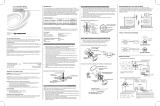 Crestron electronic GLS-OIR-C-450/1500 User manual
Crestron electronic GLS-OIR-C-450/1500 User manual
-
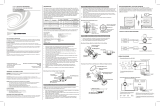 Crestron electronic GLS-ODT-C-500. GLS-ODT-C-1000 User manual
Crestron electronic GLS-ODT-C-500. GLS-ODT-C-1000 User manual
-
Crestron GLS-ODT-C-500 User guide
-
Crestron GLS-ODT-W-1200 User guide
-
Crestron GLS-OIR-W-2500 User guide
-
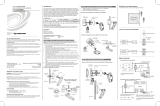 Crestron electronic GLS-ODT-W-1200 User manual
Crestron electronic GLS-ODT-W-1200 User manual
-
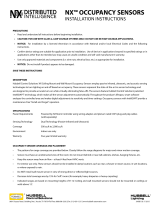 Hubbell Control Solutions NX Vacancy/Occupancy Sensor Installation guide
Hubbell Control Solutions NX Vacancy/Occupancy Sensor Installation guide
-
Intermatic IOS-HB-U Operating instructions
-
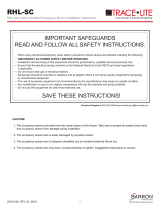 BARRON RHL Series High Performance LED Round Highbay Installation guide
BARRON RHL Series High Performance LED Round Highbay Installation guide
-
 Lutron Electronics CUS-500 Installation guide
Lutron Electronics CUS-500 Installation guide







